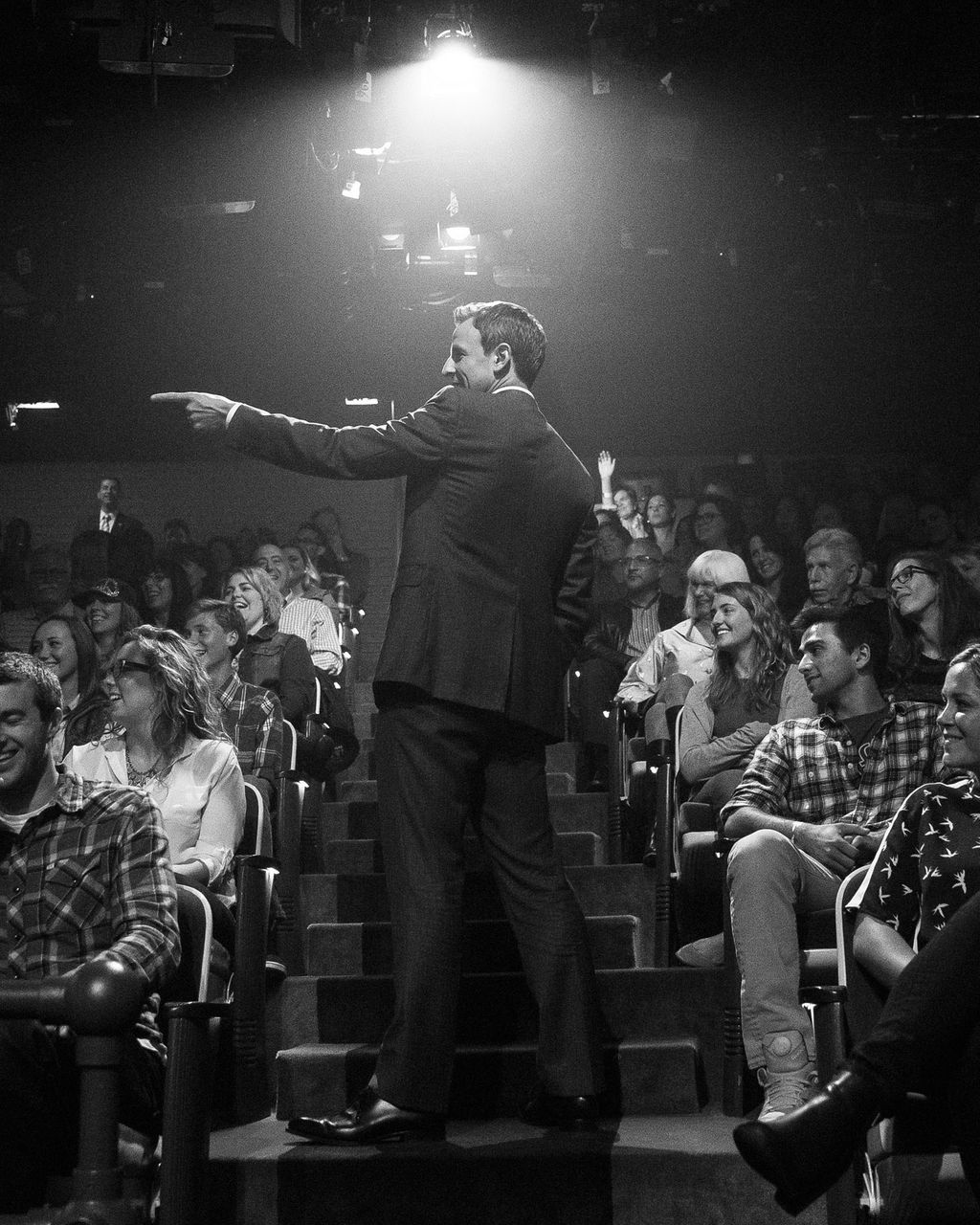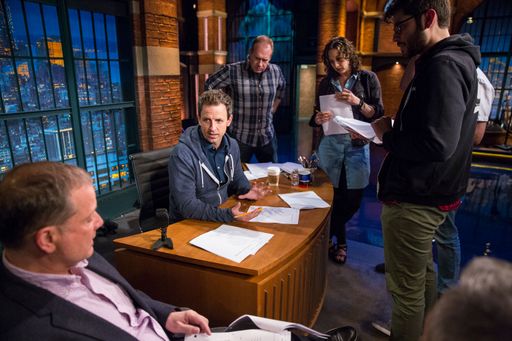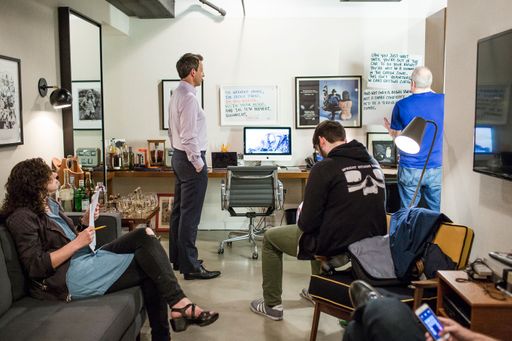On Friday, November 18, Vice-President-elect Mike Pence went to see Hamilton. He was booed by the audience and addressed directly by the cast while they were onstage. President-elect Donald Trump tweeted about it: “Our wonderful future V.P. Mike Pence was harassed last night at the theater by the cast of Hamilton, cameras blazing. This should not happen!” Expectedly, this incited a storm of controversy and debate that dominated the weekend news cycle.
On the night of Monday, November 21, Seth Meyers took “A Closer Look” at the feud. “So to sum this whole thing up,” Meyers joked, “Mike Pence is now officially the first vice-president in history to lose a duel with Hamilton.” It was a good joke — Meyers’s favorite of the night — but the segment wasn’t over. He spent the second half of the 11-minute piece on how this feud was a “distraction from a far bigger story,” specifically Trump’s business-related conflicts of interest.
In response to Vulture’s news post on the segment, commenters wrote:
“Seth, we’re going to need you to stay on this for the next four years.” —kno
“It’s sad that Seth Meyers is they [sic] guy reporting the facts while the professional ‘journalists’ are meeting in the tower to kowtow to the demagogue.” —TyWebb17C
“I’m not sure exactly when I first caught one of his ‘a closer look’ segments but in the days following the elections he was so on. Unexpectedly, this has become a must see every night for me, so glad to have it, hope more people start to catch on.” —nikki5
Nikki5 is not alone. Meyers, who never planned on playing the viral game, has seen his YouTube subscribers jump by 53 percent over the last six months, with views exceeding 36 million a month — up 143 percent since May — as reported by The Wall Street Journal. (This is in addition to more than 1.5 million people who watch the show when it airs.) Though they didn’t introduce the segment until almost 20 months after the show launched, Meyers and his team have turned A Closer Look into their biggest asset and, in turn, transformed Late Night into essential nightly viewing for political comedy.
As I learned while spending that Monday in Late Night’s eighth-floor, 30 Rock office, the piece was conceptualized less than 24 hours earlier, in a half-office in the South Slope, Brooklyn, one-bedroom apartment of Late Night writer Sal Gentile. Looking at how it came together provides a case study of how Meyers and his team have refined a distinct point of view, but also how, on a daily basis, Meyers has become the most trusted political voice in late night.
A POLITICAL COMEDIAN IS BORN
When I walk into his office Monday morning, Meyers, 42, begins pretending to type. “When I walk in,” he says, mocking how this piece might introduce him, “Seth is at his computer, hard at work.” And he was. Wearing a navy waffle sweater and with hair that has fully transitioned to graying, he’s graduated from “first college boyfriend you bring home to your parents” to “grad school professor you sometimes see at that one nice bar about a mile from campus.” Meyers was different than when I’d interviewed him before— today, he was tighter, a bit distracted. Unlike those other times, which had usually been on his off days, on this morning Meyers is working on A Closer Look.
Meyers has been in NBC’s 12:30 a.m. slot, following The Tonight Show, for nearly three years, but unlike Jimmy Fallon, who had the job before him, he came out of the gate pleasantly, but with no clear identity. Reviewing the premiere of Late Night With Seth Meyers in February 2014, Vulture’s Margaret Lyons wrote, it “needs more Seth Meyers.” There were glimpses that Meyers was trying to doing something smarter — he’d have David Remnick on to talk about Russia and jokingly comment on live performances of New Yorker cartoons — but it didn’t feel like Meyers’s show so much as Meyers hosting a somewhat generic late-night show. The introduction of A Closer Look in September of 2015, a longform desk piece that aspires to dive deep and explain a political story currently demanding attention — like a more news-cycle-driven version of what John Oliver was doing on Last Week Tonight — gave the show a more discernible point of view. In the 14 months since, the segment has become the show’s signature element, with videos like “Trump Lies about His Birther Past,” “The Trump Tape and Debate Fallout,” “Trump’s Response to the Orlando Shooting,” “Trump Attacks the Khan Family,” and “The Polls Tighten with Six Days Left” all getting over two million views on YouTube. It began as a weekly feature, but once they started to get traction and refine the process, they’ve done about three a week.
On the mornings of episodes in which he’s going to do A Closer Look, the segment is Meyers’s sole job. First drafts are always written by Gentile, a Late Night staff writer who came to the show after years working in cable news. Meyers says that usually he and Gentile text about what the topic should be, but this one was obvious: Trump v. Hamilton. Today, Gentile had sent the initial version at 2:30 in the morning. Meyers looked at it around 6 a.m., but he tells me he really starts working on it around 8 and focuses on it until about 11. (The show tapes at 6:30 p.m., with an abbreviated joke rehearsal at 4:30.)
Meyers compares Gentile’s draft to “the cowboy coming out of the milk in Westworld,” meaning, the bones of the piece are there. “We gotta put the hat on it,” he adds. Meyers also gets input from his “secret weapon,” Alex Baze, 50 — a producer on Late Night and the man Meyers has called “the best joke writer in America” ever since they worked together on Weekend Update — and his less secret weapon, Jenny Hagel, 39, a writer on the show who is on camera somewhat regularly as half the duo behind Late Night’s second-best segment, Jokes Seth Can’t Tell.
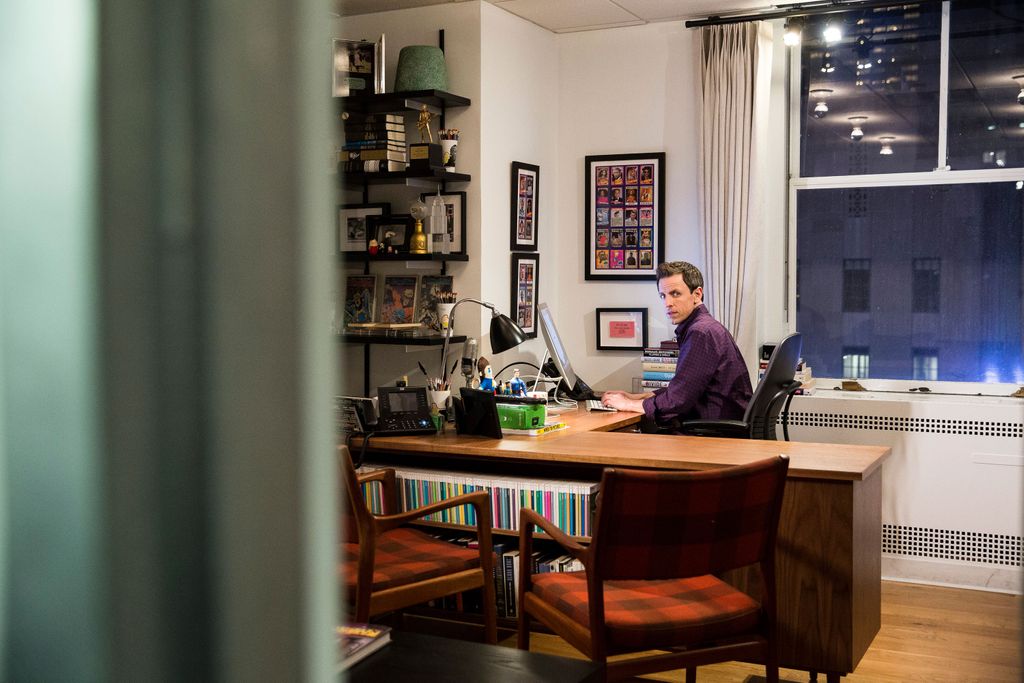
Ninety-five percent of Closer Looks are written the day of, Meyers says, because it makes the front of the show more vital for both him and the audience. It’s also just how he likes to work. If Meyers were a Major League pitcher, he’d be a fastball-throwing closer, able to pitch one inning every day. He once returned the money he was given to write a feature film after he realized he couldn’t summon the discipline to write it. Between SNL and Late Night, Meyers has become an acolyte of the Lorne Michaels school of “the show doesn’t go on because it’s ready; it goes on because it’s 11:30.” It’s the same tendency that made him give himself only three weeks between leaving SNL and starting Late Night. “If I had more time, it would not have been well spent,” he says. “The downside was, it took us like 18 months to figure out what the show was, but it wasn’t like we weren’t having a good time.”
Watching him make changes swiftly to Gentile’s intentionally long first draft, this skill is clear on a micro level. More than anything, Meyers is a brilliant comedic editor, equally adept at sharpening the humor and shaping the narrative he wants to tell in the piece. He switches the structure so it opens with Hamilton, not the news about the Trump University settlement — he wanted to end on the more important note — and cuts a section about Mike Pence going to a Broadway show despite his record on gay rights, because he feels the show hadn’t “done enough on Pence and his positions yet to assume that everybody would be fully caught up.” He removes a section about how there is a long history of booing politicians, only to put it back when he sees a joke Baze wrote for that one: “I’m sure there was a dude at the Gettysburg Address yelling ‘I got yer address! 1508 You Suck Boulevard!’” The punch line — “Trump did not admit any wrongdoing, but $25 million is a lot of money to spend if you think you’re innocent. That’s like sending your wife a bouquet of flowers with a note that says ‘I didn’t do anything wrong’” — gets tweaked to “… a note that says ‘Janet is just a friend.’”
Meyers never had designs on being a political comedian. On SNL, he was responsible for some of the show’s most famously dumb, pun-based sketches, such as “Jon Hamm’s John Ham” and its precursor, “Peter Sarsgaard’s SARS Guards.” Then in 2004, Lorne Michaels cast him to play John Kerry. As Meyers tells it, the big change happened in 2005, when he was promoted to head writer, the job he held until 2014.
One of the many responsibilities as SNL head writer is writing the sketches the show needs but no one else wants to do. That often means political material, especially in non-election years. So when the next election came up, Meyers was ready, penning Tina Fey’s now-legendary turn as Sarah Palin. Meyers’s personal political-comedy voice came into focus when he joined Weekend Update in 2006, and especially when he was at the desk solo, from 2008 to 2013. It was there Meyers did an early version of A Closer Look, in a segment called “A Closer Look at Europe” about the Greek debt crisis. Though it was significantly more joke-heavy, it shows glimmers of the same intellectual curiosity.
A year into Late Night, when Jon Stewart and Stephen Colbert were leaving their Comedy Central shows, Meyers decided to focus the show more on politics. He felt there was an opportunity to jump on election coverage before other late-night shows, and differentiate his Late Night in the process. Combined with Meyers’s introduction of a sit-down monologue — an unusual choice for a late-night show — that period signaled the start of Late Night’s shift away from the template used by his network peers and toward something more closely resembling The Daily Show. The Closer Look segments were the perfect centerpiece for the new format. The plan, as Meyers puts it, was for them to be recurring “explainers with jokes.” The first, in September of 2015, was about Planned Parenthood. The earliest mention of Trump was in an early November Closer Look about the fallout of the first Republican debate. It wasn’t until December 8, 2015, that Trump got his own Closer Look, focusing on his proposed Muslim ban.
Meyers and Samantha Bee (whose show airs once a week) were the late-night hosts who made their names over the course of the campaign. (Oliver, and to a lesser extent, Bill Maher, had already emerged.) Of his nightly competitors, the quality and clarity of Meyers’s work surpassed that of the apolitical (Kimmel, Conan) and very apolitical (Corden, Fallon), as well as Colbert’s Late Show and Trevor Noah’s Daily Show, neither of whom seemed to figure out what they wanted to be doing and who they were in the political realm.
“I felt like we had something to say, and I felt like we said it well,” Meyers tells me about how he felt after the final Closer Look before Election Day, which included this masterful turn.
He thought that would be it. Meyers had said back in March that it was getting more difficult to write Trump jokes, and now they will be the coal that powers the show for the foreseeable future. If his opening address the night of the election was any indication, he’s up to the task. It galvanized his staff with the belief that they were doing something important and deepened his trust with the audience, creating a stronger bond which is already apparent in the speed at which the Closer Looks have been shared in subsequent weeks.
Meyers did two other things that set him apart from others in late night, and many in the media. First, he admitted he had been wrong about not taking Trump’s run for president seriously. (Meyers’ underestimation of Trump dates back to his 2011 gig hosting the White House Correspondents’ Dinner, where he joked, “Donald Trump has been saying he will run for President as a Republican, which is surprising since I just assumed he was running as a joke.”) Second, he said this: “As a white man, I also know that any emotions that I’m feeling are likely a fraction of those being felt by the LGBTQ community, African-Americans, Hispanic Americans, Muslim Americans, and any number of the immigrant communities so vital to our country.” (Meyers also was smart to provide writer-performer Amber Ruffin a space to brilliantly talk about the election the following night.)
The moment felt like a breakthrough for Meyers. (The YouTube clip provided Meyers with his most views — almost seven million — of any video not featuring Jon Snow.) Like Jon Stewart after 9/11, it shows that one of the most important jobs of a daily late-night host is saying the right thing at the right time. A trust is built between host and audience: If Meyers says something really happened in the news, his audience rightly believes him.
THE MAN BEHIND THE MAN
Meyers describes Gentile as if he had been designed in a lab for this job. Were that the case, the lab technician would have been Aaron Sorkin. Gentile is the archetypal man-behind-the-man: manic in a nerdy way, stridently idealistic. Think a cross between Sam from The West Wing, Jeremy from Sports Night, Jim from The Newsroom, and Matt from Studio 60. He says things like, “Remember when there were slots on the news for lighter stories instead of it being like this relentless death march?” Glasses, bearded, he seems Jewish but isn’t. He keeps a pencil in his shirt pocket.
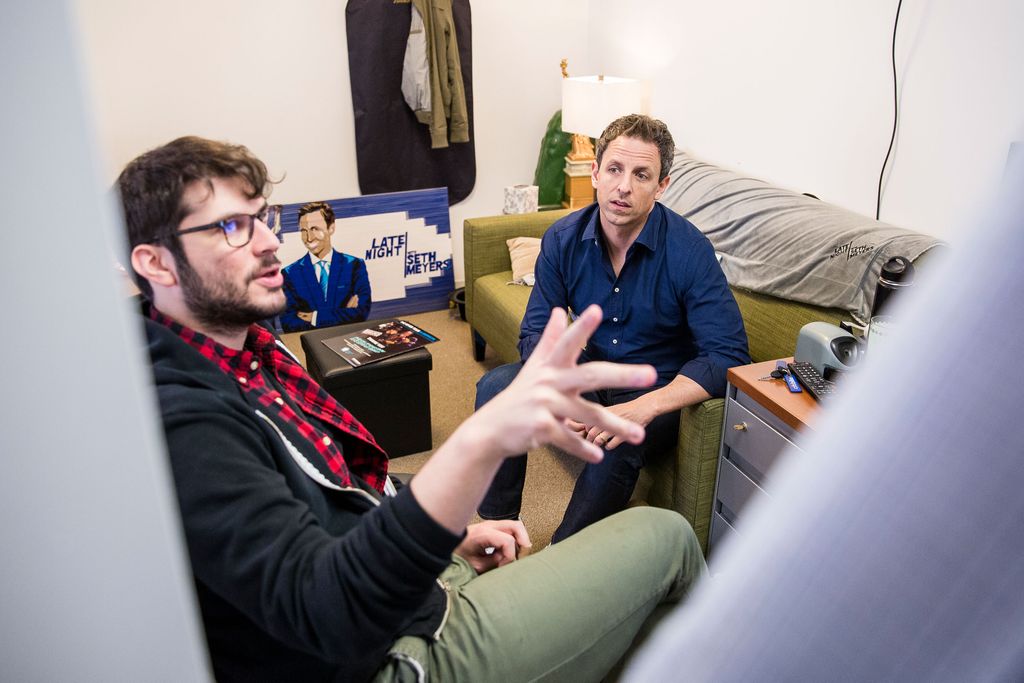
As Meyers puts it, “My SNL days of working through the night have come and gone … I deserved a Sal.” It’s unlikely that any of Meyers’s competitors would rely so heavily on a sort of one-man writer/researcher/producer, but the arrangement works, thanks to Gentile’s cable-news background and his professed appetite for consuming “an inordinate and probably unhealthy amount of news coverage.”
When Baze, Hagel, and Mike Shoemaker, 58, a Late Night producer whom Meyers also worked with at SNL, gather in Meyers’s office for the day’s Closer Look read-through around 1 p.m., Gentile literally sits on the edge of his seat. He has been working on this script for over 24 hours at this point — for Monday shows, he’ll consume the weekend’s news and write the segment all day and night on Sunday. (For midweek Closer Looks, he’ll start writing after the day’s episode tapes.) Meyers reads through the second draft quickly, conveying no emotion. “So nothing missing, right?” he asks, looking for cuts, alternate jokes, or late-breaking information.
“Batman or Hot Pockets?” he prompts the group, opening up a dialogue on whether they should go with one of two jokes:
“You had a bunch of diplomats over and you served sliders? Were you out of Hot Pockets?””Diplomats sipping champagne at a new hotel presentation. I think the most popular game the next four years is going to be ‘Scene from a Trump Presidency or Scene from a Batman movie.’ [In an affected voice] ‘With the new luxury hotel, Gotham will thrive anew!’”Meyers: “I feel like we’ve done Batman before.”
Baze: “I like Batman better than Hot Pockets, plus I like that voice.”
Gentile: “The Bane voice is fine.”
Meyers: “It wasn’t quite a Bane voice. You know I can go full Bane. I was kind of thinking it was like a rich guy.”
Gentile: “Bragging about how he can go full Bane.”
Meyers: “How many times do you think they asked Thomas Hardy not to go full Bane?”
Gentile: “’Please, please, Tom.’”
Baze: “Can you Bane it down a notch?”
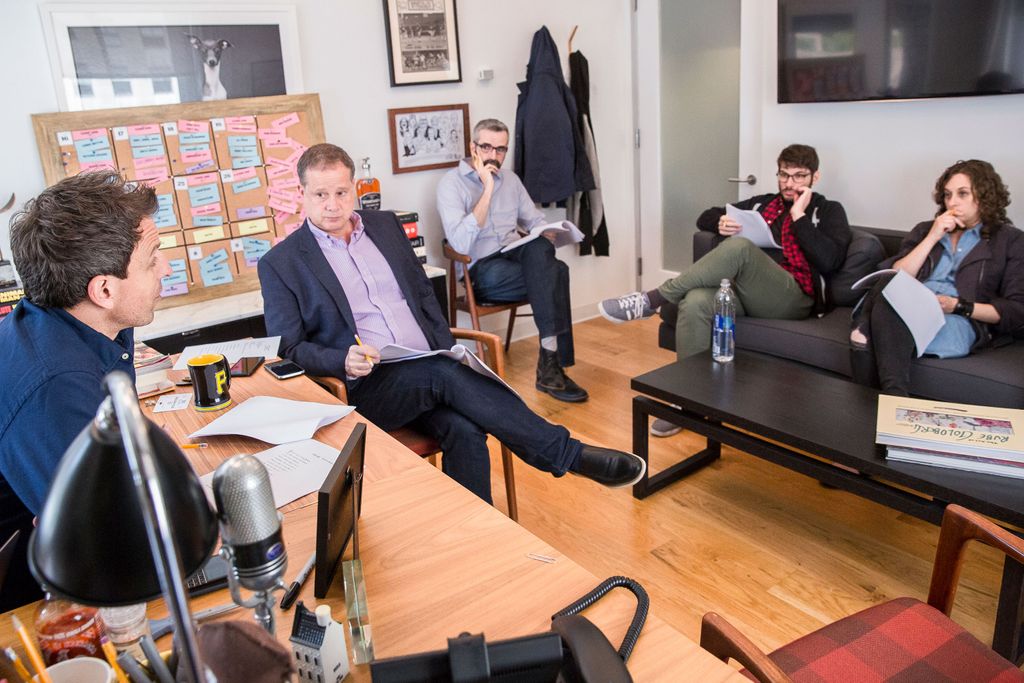
They decide to go with Batman. Baze asks, “Do we want any addressing of the theory that Hamilton was an intentional distraction from the fraud suit?” Gentile perks up, saying it’s an “interesting debate,” but he’s not sure if there is enough reporting to say if “he’s such a genius at baiting the media or just an unhinged, crazy person.”
This factual rigor is what Gentile brings to the show, and is largely what sets A Closer Look apart. “We’re going to face a challenge over the next couple of years of just consistently rededicating ourselves to the truth and what the truth is,” says Gentile, “because we’re facing an incredible media environment, political environment that’s hostile to shared facts and shared understanding.” Which fits into Meyers’s expressed goal for the segment. “We try very hard to be fair. Some people believe fair is you have to make an equal amount of jokes about both sides,” he says. “That’s not our take on fair. Our take on fair is to say things that are true and that we can back up with facts.”
“We want to get beyond the sense of outrage,” Gentile adds, explaining the difference between A Closer Look and other comparable segments in late night. Meyers rarely “destroys” topics in the same way that Oliver or Bee do so well, though that’s partially a product of being daily rather than weekly. “Being outraged every day is hard,” says Meyers. “We’re pacing ourselves and saving it for the times when you really want to hammer something home.”
That said, in an era where the dangers of “fake news” have been so heavily debated, the value of a show that nightly dedicates itself to sorting out the truth and packaging it with great jokes is undeniable. While Gentile acknowledges they aren’t journalists and that they depend entirely on the work of actual journalists, he says, “we are entering truly uncharted waters in modern American politics, but one thing is clear: Misinformation and propaganda are going to continue to proliferate. That means we all need to be on guard against it. Hopefully, the Closer Looks are well-suited to the period we’re about to enter — we can be sort of a daily check-in with reality.”
Meyers points out that, ironically, “fake news” used to mean shows like The Daily Show, which was specifically trying to parody televised news. And while Stewart did a lot of great work pointing out the hypocrisy of the Bush administration, the show spent a good deal of time doing comedic media criticism — especially against the rise of Fox News. “We were very aware that had been done, and done to probably the highest level that could possibly be done,” says Meyers. “Also, what the media did right, what the media did wrong is a far less interesting story than what [Trump’s] doing.” During Stewart’s prime, Fox News felt like a propagandist for the administration; now, the future president seems to be the main source of his own misinformation, and Late Night has adapted accordingly, whereas the current Daily Show’s inability to adequately make the same shift is partly to blame for its continued struggles.
Meyers seems content accepting that people might get their news from his show, a concept Stewart always cautioned against when data suggested as much. “I like to think we’re an excellent second source,” says Meyers. “If you’ve gotten your news from a real source, that enhances the experience of watching our show.” And in some ways, Late Night has advantages over its serious news counterparts. “We don’t have to fill 24 hours of air time,” says Gentile, “so we can be more selective about the subjects we want to tackle and the arguments we want to make, and we have the breathing room and the capacity to dive deeply into obscure topics that cable news might not necessarily cover.”
But to do that, Gentile first has to incorporate all these notes and cut maybe five minutes of material. Then, around 3:15 p.m., Gentile, salmon lunch in hand, walks down the hallway through Late Night’s office, toward the graphics department. Graphics is a small, dark room, where seven young people sit in front of large computers, Photoshopping images for the show. Gentile asks one if, instead of a silhouette of Trump’s body for the mock poster for Scamilton, can they do a silhouette of his head? “I think just his hair, his profile,” he says.
Gentile slides open a door to reveal another office, both smaller and darker than the previous one. In front of a series of giant monitors sit Tony Dolezal, a 28-year-old video editor who has been at Late Night since the start, and Alex Friedman, a 23-year-oldfootage researcher who has been with the show since January, after working as a production associate at Nightline. While he eats, Gentile approves the clips they compiled on his request. “I love the little stray ‘you suck’ at the end,” he says after watching a clip of Pence getting booed at a baseball game. They shuffle through a few more before Gentile works with Dolezal to figure out when to bring in the “what’s happening?” clip from Poltergeist, the final kicker to the piece. Dolezal shaves a few frames off, saying he wanted to build a little extra room to give people time to read the graphics. Gentile likes it shorter. “I think people will get it,” he says. They all agree. The clips, graphics, and script are locked in for rehearsal.
BUT IS IT FUNNY?
At 4:15 p.m., Meyers walks out onto the Late Night stage, and the sprint begins. “My name is Seth Meyers,” he says to the monologue test audience, “and every night I host a talk show right there,” he adds, pointing to his desk. The trial monologue audience was the invention of Shoemaker, who first installed it at Fallon’s Late Night and brought it to Meyers. It was a luxury that now feels like a necessity: Meyers will include things in the test draft knowing they might get cut if they don’t get a laugh or get the wrong laugh.
“Just so you know, I’m going to read two to three times as many jokes now as we will have in the actual show tonight,” Meyers informs the 50-person audience, gathered by a team of NBC interns sent to find people milling about 30 Rock — regardless of their primary speaking language. “What happens is, after you leave, we reconvene and we separate the winner jokes from the loser jokes,” he explains. “As far as which are the winners and which are the losers, it’s about to become abundantly clear to all of us.”
He’s wearing the same waffle sweater, but Meyers is now accessorizing it with his charming, “let’s have good time” smile. “Okay, we get started, as we have been, with Donald Trump,” Meyers says casually, before starting in on the monologue jokes. Some hits, some misses, some groans (good and bad) — each one causes the writing staff, sitting on the stage-left audience bleachers to scribble. The last joke — that ends with “If you can’t make it to Vegas, and you still want to gamble, wear your Hillary shirt” — bombs. Meyers, who seems to get a perverse pleasure when monologue jokes fail, smiles and shouts, “Okay, let’s move on!”
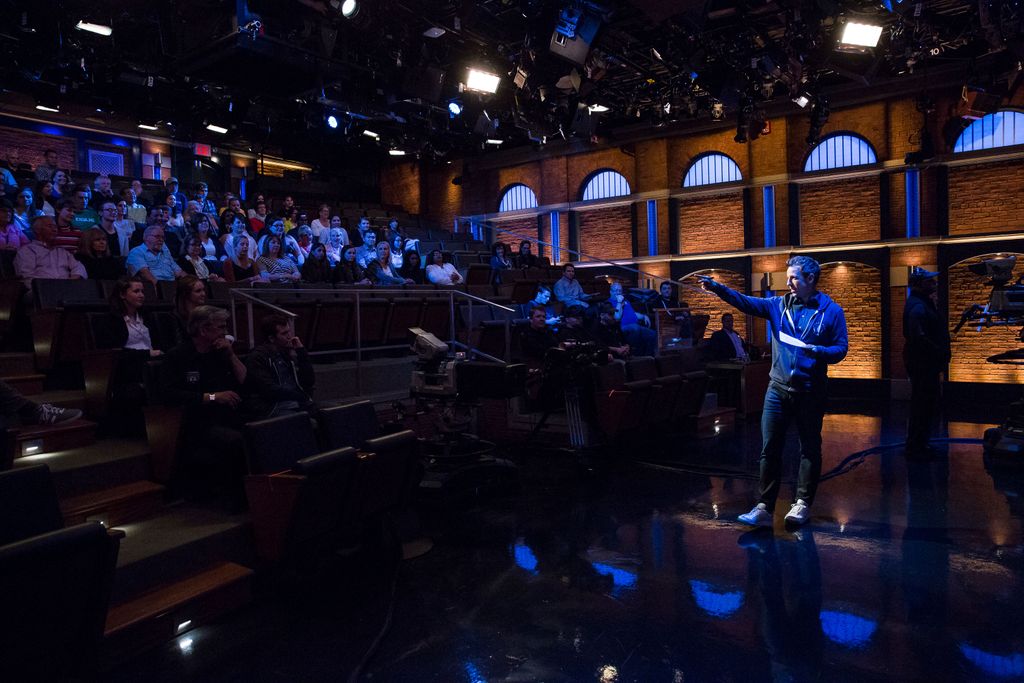
The audience laughs louder at the opening joke — “If you live in New York City, you would have bet everything you owned on Friday morning that it was impossible for people to talk more about the musical Hamilton … and by Saturday night you’d be broke” — than they did at anything from the monologue. Shortly after, a joke about how the Hamilton audience would’ve booed Stephen Sondheim if he, like Pence, arrived late, gets zero response. Meyers continues, and just the mention that Hamilton is sold out for months reenergizes the crowd. He lands another winner: “I hate to break it to you guys, but you’re not boycotting Hamilton. Hamilton is boycotting you.”
Things are stone silent during the long history of booing politicians, but the audience erupts at “1508 You Suck Boulevard!” “Janet is just a friend” gets a strange mix of awws and confused laughter. The “scene from a Batman movie” gets a decent laugh, but not much for Meyers’s full Bane impression. When Meyers throws to the Poltergeist clip, it’s clear that a couple people very much get the joke; everyone else is dead silent. And with that, Meyers thanks the audience and invites them to watch the show tonight to “see what jokes you laughed into existence and which ones you murdered with your silence.”
The stage lights turn off, Meyers sits back down, and Gentile, Shoemaker, Baze, and Hagel run to his desk, like a comedic pit crew, fixing jokes instead of tires. There are less than two hours until showtime, and they are in a rush — but first, they take a moment to make fun of how Meyers said “bourgeois,” which came out closer to brrgois. Speaking in shorthand, they scan through the script and call out cuts and changes. “’Janet is just a friend,’ they didn’t go for,” says Meyers, and Baze agrees it should go.
Shoemaker is informed the run time is currently 8 minutes and 56 seconds over. “Oh my God,” Meyers responds. Shoemaker says they will go ahead and film a sketch they were planning to use during the broadcast (it involves a prop volcano that, if they don’t use today, will explode), but hold it for another episode. “So, if we cut two minutes, we’ll be fine,” says Shoemaker. “Sal will make the cuts.”
They continue to scan. Gentile asks, “Go back to the Hot Pockets?” Meyers asks Hagel, who wrote the joke, for her original wording. Gentile scribbles.
They get to the end of the script. A resigned Gentile says, “The Poltergeist clip is not great,” and everyone agrees. They shout out ideas with increasing urgency, as this will be the clip to end the entire piece.
Meyers: “Raiders of the Lost Ark face-melting?”
Shoemaker: “Yeah, that has not worked in the past.”
Meyers: “The one scene with the head exploding?”
Baze: “You’re thinking of Total Recall? That’s a pretty good head explosion.”
Meyers: “The sad thing here is that there hasn’t been a good head exploding since the mid-‘90s.”
Hagel: “The market is really hurting …”
Shoemaker: “Is there a callback?”
Meyers: “A callback to the boos?”
Hagel: “If we go back to the baseball field? ‘Boo … you suck!’”
Meyers: “Yeah.”
Shoemaker: “Yeah.”
Baze: “So, the head explodes and then the booing.”
Shoemaker: “You’re really locked on the head exploding.”
Gentile: “Oh yeah, we saw a head exploding, it was you trying to say ‘bourgeois.’”
They laugh and Meyers tells them to “get out of here.”
That entire rewrite takes eight minutes. Gentile has about half an hour to make all the changes and remove two minutes, so Wally Feresten, Late Night’s cue-card guy (Meyers used to work with him at SNL) can put the cards together for a last read through.
At 5:45, Shoemaker calls the Closer Look writers into Meyers’s dressing room, an impeccably mid-century-modern space (that bears little resemblance to his comic-book and tchotchke-filled office), where a now clean-shaven Meyers is halfway through putting on his suit. Feresten holds up the cards in front of Meyers, and he reads through them quickly in a colorless voice. Meyers gets to the Hot Pockets joke and Feresten giggles. “You enjoy that?” asks Meyers. Gentile jokes, “But you really just want a Hot Pocket, right?” Meyers speeds through the rest, making small additions and cuts, and thanks everyone. Hagel and Gentile quickly go over the changes with a writer’s assistant. While Meyers finishes getting ready and greets the night’s guests — Kathy Griffin, Dev Patel, and chef José Andrés — Gentile rushes back to graphics and video for final looks.
By 6:30 p.m. the audience has filled the studio and the warm-up comedian, Ryan Reiss, is busy earning his paycheck. He finds out the standard stuff, like if there are couples in the audience (there are) and where people are from (Colombia, Germany, Spain, Australia, America). Fred Armisen is in town, and he leads the 8G Band in a rousing rendition of the Cars’ “Just What I Needed.” Meyers comes out, says hello, riffs with Armisen, and then he’s off. The monologue goes well, especially an Angela Merkel joke, thanks to the German contingent in attendance. He introduces the Pence vs. Hamilton news and says, as he does each time, “For more on this, it’s time for A Closer Look.” The audience woots in acknowledgement.
At this point, there aren’t any surprises. Basically, every Hamilton joke kills. But nothing hits like the Hot Pockets joke. People love that joke. And they love the ending — the callback to Pence being booed at a baseball game — none the wiser that it was added in the eleventh hour.
After the show, Meyers quickly changes back into the waffle sweater, adding a Northwestern cap to top off the ensemble. Partly because of the performance adrenaline, partly because of the salt-air margarita that chef José Andrés has prepared for him, he is looser, chatting with Shoemaker and Baze about how it went. “I shot you guys a look when Hot Pockets worked,” he says. The conversation moves on to a small problem with the night’s audience. “We had a bunch of clappers tonight,” Shoemaker tells me, adding, “not in a good way.” At one point in the night’s Closer Look, the audience tried to clap at a joke about how there are no longer any Trump casinos anywhere, and Meyers talked over them until they stopped. He’s never been a fan of “clapter,” the term he coined for when audiences clap instead of laughing.
This is at the core of what separates Meyers from his political-comedy peers, and someone like Stewart: For better or worse, Meyers is not interested in espousing opinions or parroting his audience’s opinions back to them. His one opinion is that people should have access to and focus on the correct information — and ideally they’re laughing along the way. He doesn’t have a theory of what comedy will mean under Trump because “comedy is low down the list of things” that might be affected. He wouldn’t venture to say whether passing around clips like A Closer Look precludes people from doing something more meaningful. He is okay if all his show adds up to is catharsis.
Because of this outlook, Meyers hasn’t had a crisis of purpose post-Trump. He would feel terrible, he says, if “I had not said anything.” I ask if he’s ready for a fight these next four years, and he disagrees with the premise. “I don’t know if I’m in a fight,” he says. “I just point out stuff. When you have a task every day,” he adds, “It makes it easier.” Tomorrow, he’ll come into the office, not ready for a fight, but ready for work, where Gentile’s next draft will be waiting for him. Because they all have more stuff to point out, and more Hot Pockets jokes to make.
